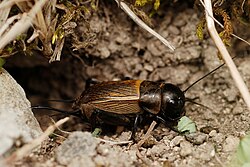Gryllidae
Family of crickets From Wikipedia, the free encyclopedia
The family Gryllidae contains the subfamilies and genera which entomologists now term true crickets. Having long, whip-like antennae, they belong to the Orthopteran suborder Ensifera, which has been greatly reduced in the last 100 years (e.g. Imms[3]): taxa such as the tree crickets, spider-crickets and their allies, sword-tail crickets, wood or ground crickets and scaly crickets have been moved or elevated to family level.[a] The type genus is Gryllus and the first use of the family name "Gryllidae" was by Francis Walker.[4]
| Gryllidae Temporal range: | |
|---|---|
 | |
| Female Gryllus campestris | |
| Scientific classification | |
| Domain: | Eukaryota |
| Kingdom: | Animalia |
| Phylum: | Arthropoda |
| Class: | Insecta |
| Order: | Orthoptera |
| Suborder: | Ensifera |
| Superfamily: | Grylloidea |
| Family: | Gryllidae Laicharting, 1781[1] |
| Synonyms[2] | |
| |
They have a worldwide distribution (except Antarctica).[2] The most familiar field crickets (Gryllinae) are characteristically robust brown or black insects;[5] the largest members of the family are the 5 cm (2 in)-long bull crickets (Brachytrupes) which excavate burrows a metre or more deep.
- Many taxa in the Ensifera may be called crickets sensu lato, including the Rhaphidophoridae – cave or camel crickets; Stenopelmatidae – Jerusalem or sand crickets; Mogoplistidae – scaly crickets; Gryllotalpidae – mole crickets; Anabrus – Mormon crickets; Myrmecophilidae – ant crickets; and Tettigoniidae – the bush crickets or katydids.
Subfamilies
Summarize
Perspective
The family is divided into these subfamily groups, subfamilies, and extinct genera (not placed within any subfamily):[2]
- Subfamily group Gryllinae Laicharting, 1781 – common or field crickets
- Gryllinae Laicharting, 1781 (now includes Sclerogryllini Gorochov, 1985)
- Gryllomiminae Gorochov, 1986 monotypic: Gryllomimus Chopard, 1936 (Africa)
- Gryllomorphinae Saussure, 1877
- †Gryllospeculinae Gorochov, 1985
- †Araripegryllus Martins-Neto 1987 Crato Formation, Brazil, Aptian ?Weald Clay, United Kingdom, Hauterivian
- †Brontogryllus Martins-Neto 1991 Crato Formation, Brazil, Aptian
- †Gryllospeculum Gorochov 1985 Dzun-Bain Formation, Mongolia, Aptian
- †Mongolospeculum Gorochov 1985 Dzun-Bain Formation, Mongolia, Aptian
- †Proararipegryllus Gorochov & Coram, 2022
- Gryllinae incertae sedis
- Capillogryllus Xie, Zheng & Liang, 2003
- †Cratogryllus Martins-Neto, 1991 Crato Formation, Brazil, Aptian
- Neogryllodes Otte, 1994
- Rhabdotogryllus Chopard, 1954
- †Sharovella Gorochov, 1985
- Spinogryllus Vasanth, 1993
- †Trichogryllus Chopard, 1936
- Itarinae Shiraki, 1930
- Landrevinae Gorochov, 1982
- Subfamily Eneopterinae Saussure, 1893 – bush crickets (American usage), not to be confused with the Tettigoniidae (katydids or bush crickets)
- Subfamily unplaced: most extinct
- genus †Achetomorpha Gorochov, 2019 Bembridge Marls, United Kingdom, Priabonian
- genus †Eneopterotrypus – monotypic Zeuner, 1937 Bembridge Marls, United Kingdom, Priabonian
- genus †Fanzus – monotypic Zessin, 2019[6] Fur Formation, Denmark, Ypresian
- genus †Gryllidium Westwood, 1854
- genus †Lithogryllites Cockerell, 1908 Florissant Formation, United States, Eocene
- genus Menonia – monotypic M. cochinensis George, 1936 (tentative placement[7])
- genus †Nanaripegryllus – monotypic Martins-Neto, 2002 Crato Formation, Brazil, Aptian
- genus †Pherodactylus – monotypic Poinar, Su & Brown, 2020, Burmese amber, Myanmar, Cenomanian
- genus †Proeneopterotrypus Gorochov, 2019 – monotypic †P. danicus (Rust, 1999) Fur Formation, Denmark, Ypresian
See also
References
External links
Wikiwand - on
Seamless Wikipedia browsing. On steroids.
